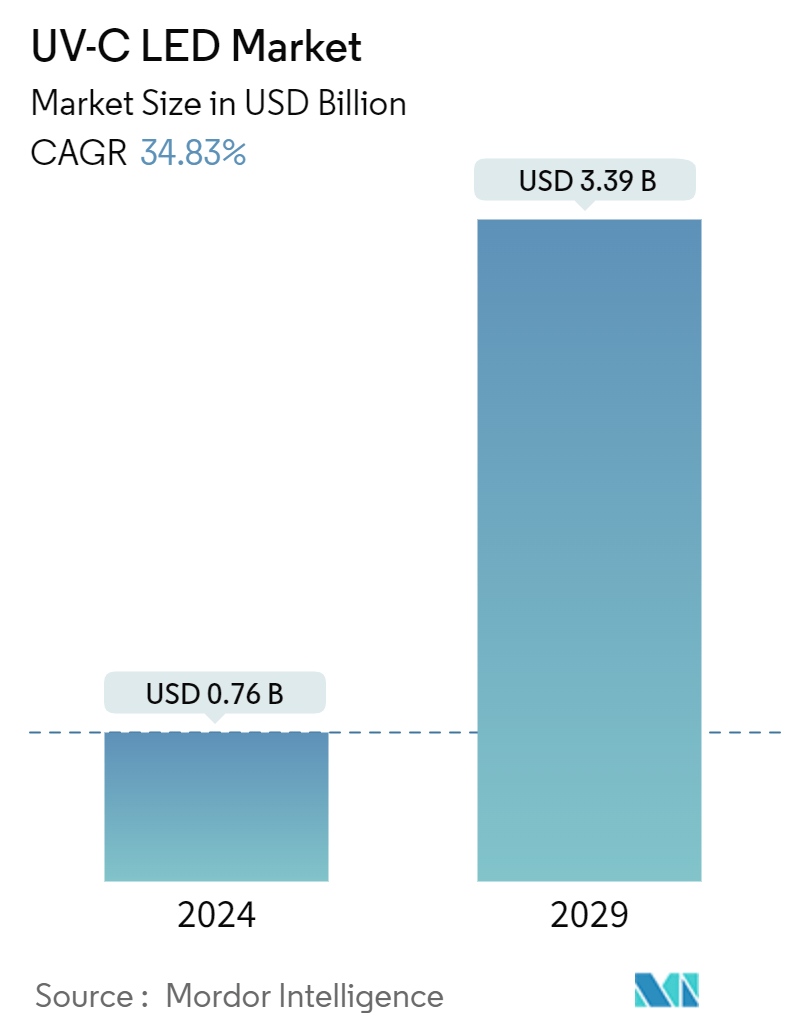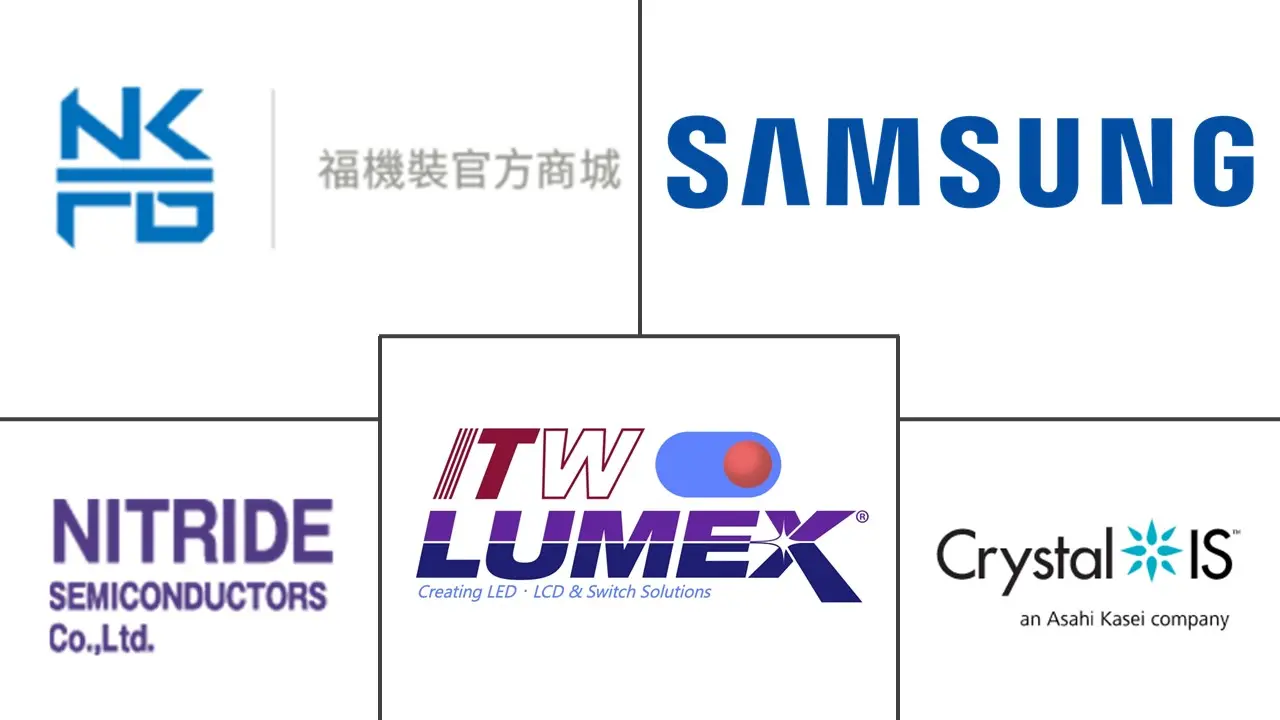Market Size of UV-C LED Industry

| Study Period | 2019 - 2029 |
| Market Size (2024) | USD 0.76 Billion |
| Market Size (2029) | USD 3.39 Billion |
| CAGR (2024 - 2029) | 34.83 % |
| Fastest Growing Market | Americas |
| Largest Market | Asia Pacific |
Major Players
*Disclaimer: Major Players sorted in no particular order |
UV-C LED Market Analysis
The UV-C LED Market size is estimated at USD 0.76 billion in 2024, and is expected to reach USD 3.39 billion by 2029, growing at a CAGR of 34.83% during the forecast period (2024-2029).
UV-C LEDs produce UV photons through the electroluminescence of a semiconductor crystal; these semiconductor crystals are typically made of AlGaN compounds grown on sapphire or AlN substrates. These solid-state devices contain no mercury and do not rely on other substances that are subject to environmental restrictions; as a result, they may provide a regulatory-proof alternative to traditional mercury-containing UV lamps.
- UV-C LEDs are germicidal, which treats microorganisms and prevents them from becoming resistant to chemical disinfectants. As a result, microorganisms do not develop resistance to UV radiation. UV-C LEDs have a wide range of applications, including air, food, and water purification. UV-C is weak at the Earth's surface because the atmosphere's ozone layer blocks it.
- UV-C LED disinfection is a new technology that uses light to damage the DNA of pathogens. This technology offers a variety of unique benefits when compared to conventional UV purification. The UV-C LEDs are expected to have a lasting effect on disinfecting water, surfaces, and air, like the effect of visible LEDs in the display market.
- UV-C LED technology is progressing quickly and receiving considerable interest across various industries. Due to increasing environmental concerns regarding traditional disinfection methods, UV-C LEDs offer an eco-friendlier option. Unlike traditional UV-C lamps, UV-C LEDs do not contain mercury, eliminating the necessity for special disposal methods and decreasing the risk of environmental pollution.
- Additionally, the energy efficiency and extended lifespan of UV-C LEDs contribute to reduced energy usage and waste production. These factors are expected to drive growth in the UV-C LED market in the foreseeable future.
- Additionally, UV-C LEDs can generate UV-C light in systems that circulate air or water. Some key factors advancing the growth of UV-C LEDs include the rapid expansion of the use of environment-safe LEDs and the growth in the application of UV curing systems.
- Since UV-C LED is very effective at disinfection, a surge in the adoption of water purification is a significant factor driving the growth of the global UV-C LED industry. However, the thermal management of UV-C LEDs is considered a significant issue with the technology and restraint to the growth of the market studied.
- The COVID-19 outbreak affected the expansion of the UV-C LED market. The development of COVID-19 has sparked a meteoric rise in interest in germicidal ultraviolet (UV) technology. SARS-CoV-2 and other pathogens can be rendered inactive on surfaces, in the air, and water by UV-C band radiation (100-280 nm) produced by conventional or LED sources. Around the world, numerous universities and laboratories are creating UV-C LED-based products to stop the spread of infections. As a result, the COVID-19 pandemic's introduction has led to a significant increase in the UV-C LED market.
UV-C LED Industry Segmentation
The UV-C LED market is defined by the revenue from the sales of UV-C LED products used in various applications, including surface, air, and water disinfection. Additionally, the market analyzes revenue accrued through UV-C LED product sales and demand across several regions, including the Americas, Asia, Australia and New Zealand, Europe, and the Middle East and Africa. The study comprises an estimation of the market size in terms of volume and value. It further analyzes the overall impact of COVID-19 on the market ecosystem. Applications for UV-C LEDs include the purification of food, surface, air, and water.
The UV-C LED market is segmented by application (surface disinfection, air disinfection, water disinfection) and geography (Americas, Asia, Australia and New Zealand, Europe, Middle East and Africa). The report offers market forecasts and size in volume (units) and value (USD) for all the above segments.
| By Application | |
| Surface Disinfection | |
| Air Disinfection | |
| Water Disinfection |
| By Geography | |
| Americas | |
| Asia | |
| Australia and New Zealand | |
| Europe, Middle East and Africa |
UV-C LED Market Size Summary
The UV-C LED market is poised for significant growth, driven by its eco-friendly and efficient disinfection capabilities. Unlike traditional UV-C lamps, UV-C LEDs are mercury-free, reducing environmental impact and regulatory concerns. These solid-state devices are gaining traction across various applications, including air, water, and surface purification, due to their ability to effectively eliminate microorganisms without fostering resistance. The technology's rapid advancement and increasing adoption in sectors such as healthcare and water treatment underscore its potential to revolutionize disinfection processes. The COVID-19 pandemic has further accelerated interest in UV-C LEDs, highlighting their effectiveness in inactivating pathogens, thereby boosting market demand.
The Asia-Pacific region is expected to dominate the UV-C LED market, supported by strong demand for water purification and advanced disinfection technologies. Countries like South Korea and Japan are leading suppliers, with ongoing innovations enhancing their market presence. The region's focus on efficient water and wastewater treatment, coupled with government support for UV-C LED adoption, is driving market expansion. Key players in the industry are leveraging strategic partnerships and product launches to strengthen their offerings. The market's fragmented nature, with both global and regional players, fosters competition and innovation, ensuring sustained growth in the coming years.
UV-C LED Market Size - Table of Contents
-
1. MARKET INSIGHTS
-
1.1 Market Overview
-
1.2 Impact of COVID-19 and Macroeconomic Factors on the Market
-
1.3 Industry Attractiveness - Porter's Five Forces Analysis
-
1.3.1 Bargaining Power of Suppliers
-
1.3.2 Bargaining Power of Buyers
-
1.3.3 Threat of New Entrants
-
1.3.4 Threat of Substitutes
-
1.3.5 Intensity of Competitive Rivalry
-
-
1.4 Pricing Analysis
-
1.5 Overall UV Lamp Analysis
-
1.6 UV-C LED Technology - Manufacturing Process
-
-
2. MARKET SEGMENTATION
-
2.1 By Application
-
2.1.1 Surface Disinfection
-
2.1.2 Air Disinfection
-
2.1.3 Water Disinfection
-
-
2.2 By Geography
-
2.2.1 Americas
-
2.2.2 Asia
-
2.2.3 Australia and New Zealand
-
2.2.4 Europe, Middle East and Africa
-
-
UV-C LED Market Size FAQs
How big is the UV-C LED Market?
The UV-C LED Market size is expected to reach USD 0.76 billion in 2024 and grow at a CAGR of 34.83% to reach USD 3.39 billion by 2029.
What is the current UV-C LED Market size?
In 2024, the UV-C LED Market size is expected to reach USD 0.76 billion.

